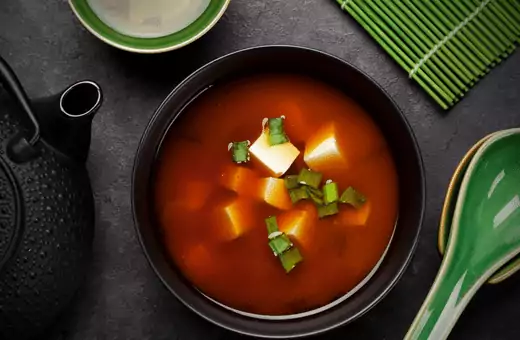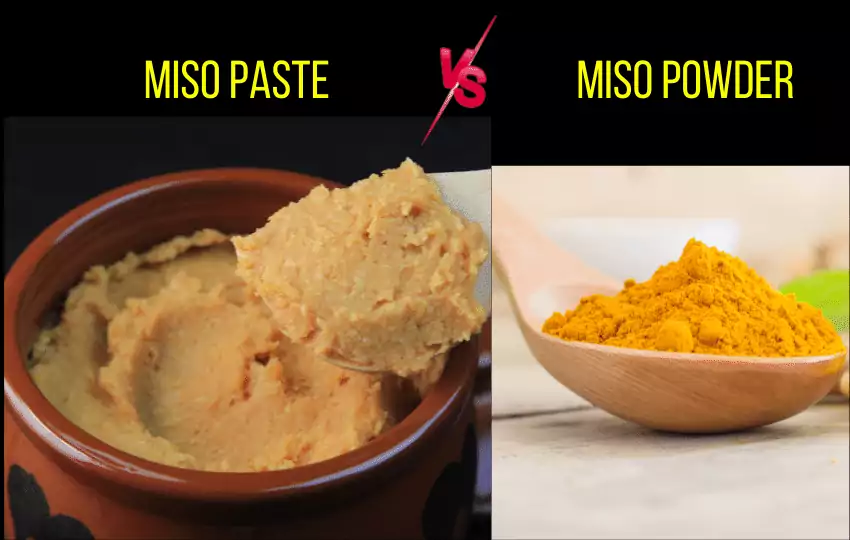Miso paste and miso powder are two widely used miso products in Japanese cuisine has almost similar taste profiles with uses but Is miso powder the same as miso paste?- this is the most asked question for using in Dashi or miso soup.
Some people like miso paste over powder because more subtle and last longer with different forms of white, red, and mixed miso.
It has an umami savor, now widely spread globally. So, today I’m going to clear your doubt about miso powder vs paste – which is better and when to use them.
Which is better- miso paste vs powder for cooking?
What is miso powder?
Miso powder is a seasoning made from fermented soybeans. It adds flavor to dishes such as soup, stews, and marinades. Miso powder can be found in Asian markets or online.
Miso powder ingredients
- Soy Beans,
- Rice ,
- Salt, and
- Tapioca Maltodextrin.
How to make miso powder at home?
If you want to make your own miso powder at home, it’s actually quite simple. All you need is some miso paste and a food processor or blender.
Simply blend the miso paste until it forms a fine powder. You can then use this powder to add flavor to soups, sauces, and other dishes. It’s also a great way to add depth of flavor to homemade marinades and dressings.
Just be sure to store your miso powder in an airtight container in the fridge, which will keep for up to six months.
How to use miso powder?
Miso powder is a key ingredient in many Japanese dishes and can be used in various ways. Miso paste is made by fermenting soybeans with salt and koji (a type of fungi) and then grinding the resulting mixture into a fine powder.
This powder can be used to make soup, stew, or marinade. It can also be used as a seasoning for noodles or vegetables.
To use miso powder, first dissolve it in water to form a paste. Then, add this paste to soups, stews, or marinades as desired. You can also season noodles or vegetables with miso powder before cooking them.
Experiment with different amounts of miso powder to find the perfect flavor for your dish.
What is a miso paste?
Miso paste is a traditional Japanese seasoning made from fermented soybeans and salt. It adds flavor to soups, stews, and other dishes. Miso paste is high in protein and fiber, and it contains a variety of vitamins and minerals.
Miso paste is also a great way to flavor sauces, marinades, and dressings. Simply whisk it into your favorite recipe for an instant flavor boost.
Miso paste is a fermented soybean paste used in Japanese cooking. It has a salty, earthy flavor and is used to make miso soup and many other dishes.
Miso paste is available in most Asian shops and online. It is typically stored in the refrigerator and will keep for several months.
Miso Paste Ingredients
- Fermented Soybean Paste
- Koji
- Salt
- Rice, Barley, & seaweed
What does miso taste like?
Miso paste is made from fermented soybeans and has a salty, umami taste. It is often used as a seasoning or condiment in Asian cuisine.
What is miso paste used for?
Miso paste is a familiar ingredient in Japanese cooking and can be used in various dishes. Some popular uses for miso paste include making miso soup, using it as a marinade or glaze for meats or vegetables, and adding it to sauces or dressings.
Miso paste is also a good source of umami flavor, which can help round out the flavors in a dish.
You can also check- Doenjang VS Miso
Is miso powder the same as miso paste?
Miso powder and miso paste are made from soybeans, but the two have some key differences. Miso powder is made by grinding up dried soybeans into a fine powder, while miso paste is made by fermenting cooked soybeans with salt and koji (a type of mold).

The fermentation process gives miso paste its characteristic umami flavor, while miso powder has a more neutral taste. Because of this, miso paste is typically used as a seasoning or condiment, while miso powder can be used in place of other flour-based ingredients like wheat flour.
Can you make miso paste from miso powder?
Yes, miso paste can be made from miso powder. To do so, simply mix the powder with water according to the ratio listed on the package (typically 1:1 or 2:1), then let it sit for a few minutes to thicken. If you want a smoother paste, you can blend it with some additional water.
When the paste has reached the proper consistency, transfer it to a clean container and store it in the fridge for up to a month.
Can you use miso powder instead of miso paste?
Yes, you can use miso powder instead of miso paste. The powder is more concentrated, so you’ll need to use less. Miso powder is also a good option if you’re looking for a gluten-free alternative to miso paste.
Can I substitute oyster sauce for miso paste?
Yes, you can substitute oyster sauce for miso paste. Oyster sauce is made from oysters, while miso paste is made from fermented soybeans. They both have a savory, umami flavor.
You can use oyster sauce as a 1:1 substitute for miso paste. Keep in mind that oyster sauce is saltier than miso paste, so you may need to adjust the seasoning of your dish accordingly.
Oyster sauce can be used in many different dishes, such as stir-fries, sauces, and marinades.
It can also be utilized as a dipping sauce or condiment. If you’re looking for a miso-like flavor in your dish, oyster sauce is a good option.
Bottom Line- Miso Powder VS Miso Paste
There are a few factors to consider when deciding between miso paste and powder for cooking. The very first thing to consider is how you intend to use the miso.
Miso paste is typically used in dishes that require a longer cooking time, while miso powder is more suited for dishes that are cooked quickly.
Additionally, miso paste has a stronger flavor than miso powder, so if you are looking for a more subtle flavor, the powder may be a better choice. Eventually, it comes down to individual preference and what you think will work best with the dish you are preparing.
Another factor to consider when deciding between miso paste and powder is the texture. Miso paste is typically smoother than miso powder, so if you want a creamier consistency, the paste may be the way to go.
However, both types of miso can be used to achieve a variety of textures, so again, it comes down to personal preference.
Finally, the cost can be a factor when deciding between miso paste and powder. Miso paste is typically more expensive than miso powder.
However, the price difference will vary depending on the brand and where you purchase it. Ultimately, it is up to you to decide which type of miso is worth the investment.
If you are still doubtful, why not try both? Miso paste and powder can both be used to create delicious dishes, so experiment and see what you prefer. There is no wrong answer when it comes to miso!
Others might prefer the paste form because it has a stronger flavor. However, it all comes down to what you prefer in your cuisine.

